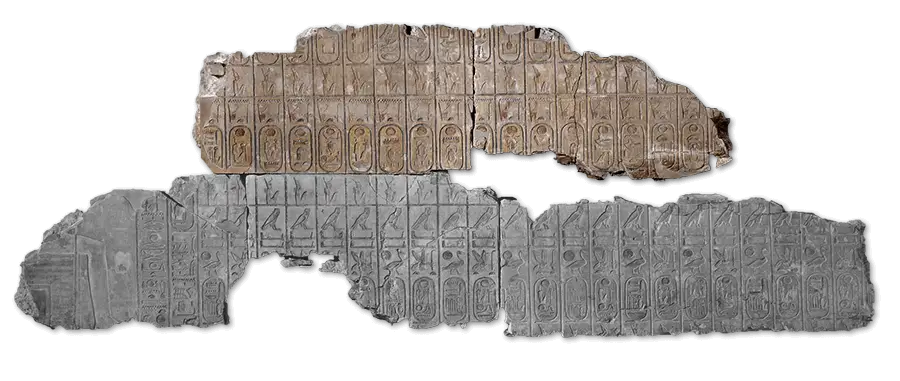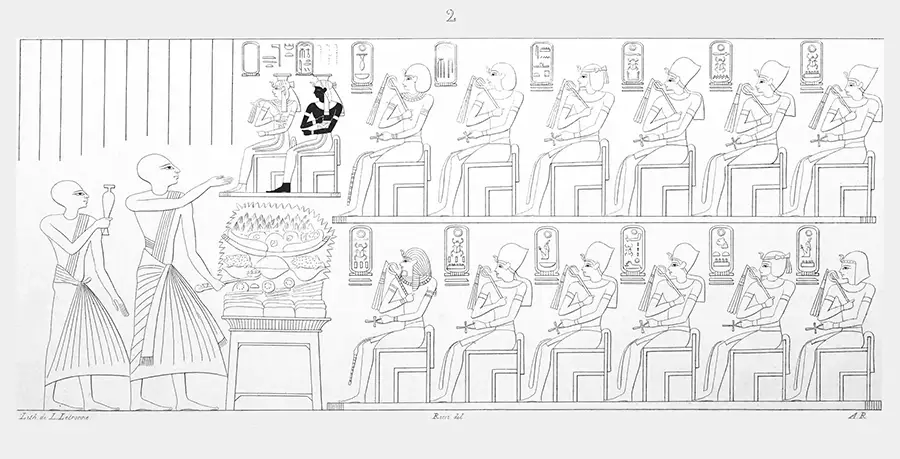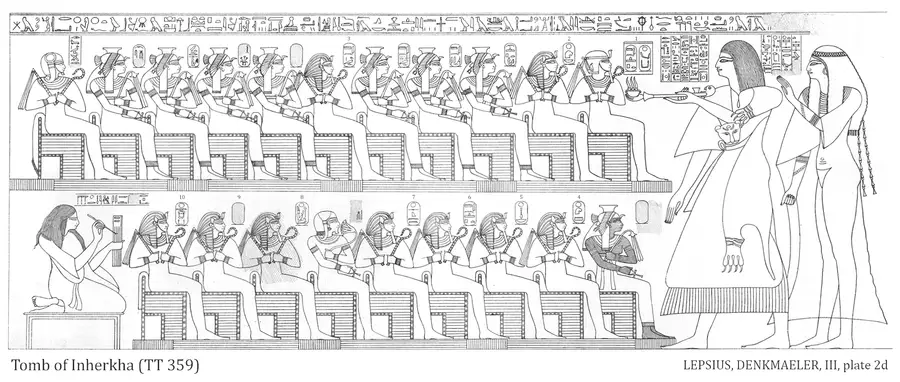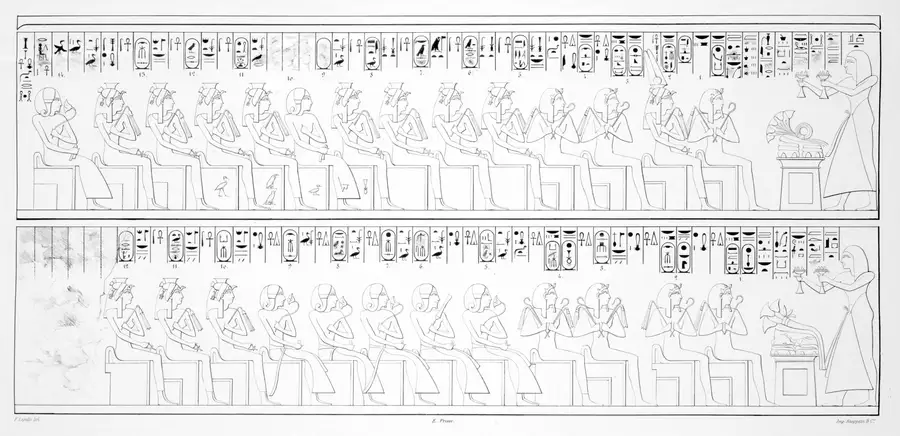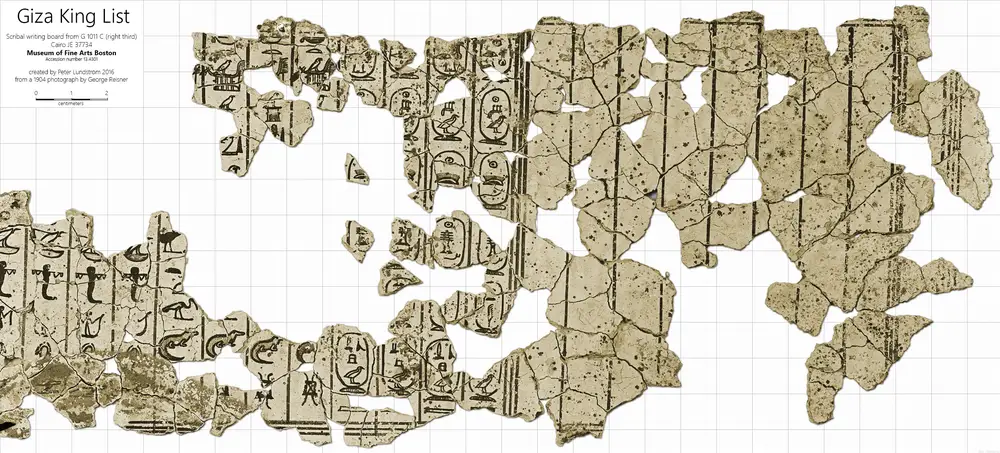There are a number of king lists that are not as well known as the larger canons that were inscribed on temple walls. They come from various periods but all have in common that they contain the names of at least five kings.
Abydos king list of Ramesses II
30 pharaohs
Date: 19th dynasty
Provenance: Temple of Ramesses II at Abydos → Kingston Lacy → British Museum
Description: The memorial temple of Ramesses II at Abydos was excavated by William John Bankes in 1818, where this tablet of kings was found. It was acquired by the British Museum in 1837, as inventory number EA 117. It was inspired by the nearby Abydos Canon, the king list of Ramesses’ father Seti I, with the names of Ramesses added, and likely adorned one of the walls of the temple. While most of the inscribed names are identical to those in the Abydos Canon, some use slightly different signs.
- Top row: same sequence as 40–52 on the Abydos Canon. The names are badly damaged.
- Middle row: same sequence as 61–76 on the Abydos Canon, + Ramesses II’s prenomen and nomen.
- Bottom row: repeating Ramesses II’s nomen and prenomen.
| # | Top row right to left | AC | # | Middle row right to left | AC |
|---|---|---|---|---|---|
| 1 | Netjerka(ra) | 40 | 14 | Nebukaura | 61 |
| 2 | Menka(ra) | 41 | 15 | Khakheperura | 62 |
| 3 | Neferkara | 42 | 16 | Khakaura | 63 |
| 4 | Neferka(ra) Nebseneb | 43 | 17 | Nimaatra | 64 |
| 5 | Djedkara Shemai | 44 | 18 | Maakherura | 65 |
| 6 | Neferkara Khendu | 45 | 19 | Nebpehtyra | 66 |
| 7 | Merenhor | 46 | 20 | Djoserkara | 67 |
| 8 | Seneferka(ra) | 47 | 21 | Aakheperkara | 68 |
| 9 | Nikara | 48 | 22 | Aakheperenra | 69 |
| 10 | Neferkara Tereru | 49 | 23 | Menkheperra | 70 |
| 11 | Neferka(Hor) | 50 | 24 | Aakheperura | 71 |
| 12 | Neferka(ra) Pepiseneb | 51 | 25 | Menkheperura | 72 |
| 13 | Neferkamin Anu | 52 | 26 | Nebmaatra | 73 |
| 27 | Djoserkheperu Setepenamun | 74 | |||
| 28 | Menpehtyra | 75 | |||
| 29 | Menmaatra | 76 | |||
| 30 | Usermaatra | ||||
| 31 | Ramessu Meryamun |
Bibliography
- Bankes., 1820. National Trust NT 1257799. Unpublished.
- Champollion, J. F., 1826. Lettres, plate 6
- Young, T., 1828. Hieroglyphics, Vol. 2: plate 47
- d’Avennes, Prisse., 1847. Monuments, plate 2
- British Museum webpage for object EA117.
Genealogy of Ankhefensekhmet
18 pharaohs
Date: 22nd dynasty
Provenance: Memphis, Egypt → Egyptian Museum of Berlin
Description: A genealogy of Ankhefensekhmet, a Memphite priest of Sekhmet during the 22nd Dynasty. This limestone block is presumably(?) all that remains of his tomb. The four rows are read from top right to left, for a total of 60 ancestors, though some are lost. The text describes several ancestors, some are accompanied by the phrase “in the reign of” followed by the name of a king. It is on display at the Egyptian Museum in Berlin, and is designated Berlin 23673 or ÄM 23673.
| # | First row right to left | # | Second row right to left |
|---|---|---|---|
| 12-13 | Psusennes I (nomen) Pa seba kha [en] niut | 2-5 | Ramesses II User Maat Ra, setep en Ra |
| 14 | Psusennes I (prenomen) Aa kheper Ra, setep en A[mun] | 6-7 | Seti I Men Maat Ra |
| 15 | Amenemnesut Amen em nesu | 8 | Horemheb Djoser kheperu Ra, setep en Ra |
| 11-12 | Amenhotep III Neb Maat Ra | ||
| 14 | Thutmose III Men kheper Ra |
| # | Third row right to left | # | Fourth row right to left |
|---|---|---|---|
| 2 | Amenhotep I Djoser ka Ra | 1+3 | Senusret III Kha kau Ra |
| 4 | Ahmose I Neb pehty Ra | 4 | Amenemhat II Nub kau Ra |
| 5 | Apepi ipp | 5 | Senusret I Kheper ka Ra |
| 6 | Sharek Sharek | 6 | Amenemhat I Sehotep ib Ra |
| 12 | Aqen? Aaqen | 13 | Mentuhotep II Neb pehty Ra |
| 13 | Ibi Iby |
Bibliography
- Borchardt, Ludwig., 1935. Die Mittel zur zeitlichen Feststellung von Punkten der ägyptischen Geschichte und ihre Anwendung. QFZ 2, Cairo 1935, 99–100, pls. 2–2a (between pp. 96–97). Cairo.
- Porter and Moss., 1981. Topographical Bibliography, III2 Memphis. Part 2: 751.
- Object listing on Berlin Museum webpage (accessed March 10, 2024.)
Tomb of Amenmose
12 pharaohs
Date: Early Nineteenth Dynasty (Seti I)
Provenance: Dra Abu el-Naga, Theban Tomb 19 (TT 19), broad hall, left half, rear wall, middle register
Description: First prophet of ‘Amenophis of the Forecourt’, i.e. the funerary cult of Amenhotep I. The scene shows Amenhotep and a priest before two rows of six seated kings with two queens inset before the kings. Preserved by the drawings of Champollion and Rosellini. The scene was severely damaged already in the 1800s, now presumed destroyed.
| Top row | Bottom row |
|---|---|
| Mentuhotep II Neb hapet ra | Amenhotep II Aa kheperu ra |
| Ahmose I Neb pehty ra | Thutmose IV Men kheperu ra |
| Amenhotep I Amenhotep | Amenhotep III Neb maat ra |
| Thutmose I Aa kheper ka ra | Horemheb Djoser kheperu ra setep en ra |
| Thutmose II Aa kheper en ra | Ramesses I Men pehty ra |
| Thutmose III Men kheper ra | Seti I Men maat ra |
Bibliography
- Rosellini, Ippolito., 1832. I Monumenti dell’ Egitto e della Nubia. Plate 45 (3).
- Champollion, "Jean-François., 1844. Monuments de l’Égypte et de la Nubie, plate 184 (2)
- Foucart, George., 1935. Le tombeau d’Amonmos, MIFAO, 57.4: plates 11, 12.
- Porter and Moss., 1960.Topographical Bibliography, I2: 33 (4 II 1)
- Kitchen, Kenneth A., 1980. Ramesside Inscriptions, III: 392. § 183 E
- Kitchen, Kenneth A., 2000. Ramesside Inscriptions. Translated and Annotated., III: 284.
Tomb of Inherkhau (Anhurkhawy)
7 pharaohs
Date: Reign of Ramesses IV (dynasty XX)
Provenance: Deir el-Medina, Theban Tomb 359 (TT 359), room F
Description: and wife making offerings before two rows of seated kings, queens, and princes, with Huy, painter, at end of lower row. Now almost completely
destroyed, but preserved by Lepsius’ drawing.
Presenting incense to the Lords of Eternity, the Magnates of Everlasting; by the Osiris, Chief of Workmen in the Place of Truth, Superintendent of Works in the Horizon of Eternity, wherein one rests, Anhurkhawy, justified for eternity; and (by) his sister, Lady of the house, Chantress of Amun-Ra, King of the Gods, Wab(et); her dear daughter, Sheritra; and her dear daughter, Sheritra; and her dear daughter, Tu[y(?)....].
| # | Upper row | # | Lower row |
|---|---|---|---|
| 1 | Djoser ka ra Amenhotep (Amenhotep I) | [Queen Ahmose-Nefertari] | |
| 2 | Neb pehty ra (Ahmose I) | 4 | Men pehty ra (Ramesses I) |
| (Queen) Ahhotep | 5 | Neb hapet ra (Mentuhotep II) | |
| (Queen) Merytamun | 6 | Amenhotep | |
| (Queen) Sitamun | 7 | Seqen en ra (Seqenenra) | |
| 3 | Prince Siamun | (Prince) [...]mose | |
| (Queen) [....] | 8 | Heqa maat ra setep en Amun (Ramesses IV) | |
| (Queen) H[enut-me]hit(?) | 9 | [....] | |
| (Queen) Tures | 10 | Aa kheper ka ra (Thutmose II) | |
| (Queen) Ahmose[....] | Noble [and Scribe?], Huy, justified before the gods. | ||
| (Prince) Osiris, Sipair |
Bibliography
- Lepsius, K. R., 1849. Denkmaeler aus Aegypten, III: plate 2d
- Porter and Moss. Topographical Bibliography, I2: 422 (4)
- Photo gallery at IFAO Deir el Medina archive: Photo gallery of the list , and TT359.
- Kitchen, K. A., 1983. Ramesside Inscriptions, VI: 185 (§ 100 D)
- Kitchen, K. A., 2000. Ramesside Inscriptions. Translated and Annotated, VI: 145
Tomb of Khabekhnet
6 pharaohs
Date: Reign of Ramesses II (Dynasty XIX)
Provenance: Deir el-Medina, Theban Tomb 2 (TT 2), now in Berlin Museum (Inv. No. ÄM 1625)
Description: The deceased making offering before two rows of seated kings, queens, and princes.
| # | Name in Upper row | # | Name in Lower row |
|---|---|---|---|
| 1 | Lord of Both Lands, Djoserkara, Lord of Crowns, Amenhotep I | 1 | Lord of Both Lands, Nebhapetra, Lord of Crowns, Mentuhotep II |
| 2 | Lady of Both Lands, Ahmose-Nefertari, may she live and abide. | 2 | Lord of Both Lands, Nebpehtyra, Lord of Crowns, Ahmose I |
| 3 | Lord of Both Lands, Seqenenra, Lord of Crowns, Tao the Valiant, given life like Ra. | 3 | The Good God, Lord of Both Lands, Seqentnebra(?)*, given life. |
| 4 | Lady of Both Lands, Ahhotep, given life like Ra. | 4 | Lord of Both Lands, Wa[djkhe]perra, Lord of Crowns, Kamose, given life like Ra forever. |
| 5 | King's sister, Lady of Both Lands, Merytamun, may she live. | 5 | King's Son, Binpu, given life like Ra. |
| 6 | King's sister, Ta-ireses(?), may she live. | 6 | King's Son, Wadjmose. |
| 7 | God's Mother, Kaes-Mut, may she live. | 7 | King's Son, Ramose, given life like Ra. |
| 8 | King's sister, Sitamun, may she live. | 8 | King's Son, Nebenkhuru(?), given life. |
| 9 | King's Son [....] | 9 | King's Son, Ahmose, given life like Ra. |
| 10 | [Royal Lady ....] | 10 | God's Wife, Lady of Both Lands, Kamose, may she live. |
| 11 | Great Royal Wife, Hent-Tamehu, may she live. | 11 | God's Wife, Lady of Both Lands, Sitirbau, may she live. |
| 12 | Kings's Wife, Tures, may she live. | 12 | God's Wife, Lady of Both Lands, Takheredqa, may she live forever. |
| 13 | God's Wife, Lady of Both Lands, Ahmose, may she live and abide like Ra. | 13 | God's Wife, Lady of Both Lands, [....] |
| 14 | King's Son, Sapair, may he live, and abide live Ra forever and ever. | 14 | Lost .... |
* The name Seqentnebra in the third position on the lower row is likely to be Senakhtenra considering that the other kings mentioned are Ahmose and his predecessors. The cartouche is badly damaged, and the line drawings from the 19th century show different readings, so it is quite possible that the name was in fact Senakhtenra.
Bibliography
- Young, T., 1828. Hieroglyphics, II, plate 97.
- d’Avennes, E. Prisse., 1847. Monuments Egyptiens, plate 3.
- Lepsius, K. R., 1849. Denkmaeler aus Aegypten, III, plate 2a.
- Porter and Moss., 1960. Topographical Bibliography, I2: 7.
- Kitchen, K. A., 1980. Ramesside Inscriptions, III: 806-807 (§ 299 G)
- Kitchen, K. A., 2000. Ramesside Inscriptions. Translated and Annotated, III: 539-40
Giza king list
6 pharaohs
Date: Dynasty V
Provenance: Giza Mastaba G1011 pit C - JE 37734 - Museum of Fine Arts Boston (Accession no. 13.4301)
Description: The Giza writing board was made of polished cedar wood and gypsum, presenting a short list of six pharaohs from different dynasties.
Names on the board, bottom to top
| Name in cartouche | Pharaoh | Dynasty |
|---|---|---|
| Bedjau | Hotepsekhemwy | II |
| Teti | Sekhemkhet | III |
| Radjedef | Radjedef | IV |
| Khafra | Khafra | IV |
| Sahura | Sahura | V |
| Neferirkara | Neferirkara I Kakai | V |
Bibliography
- Brovarski, E., 1987. Two Old Kingdom writing boards from Giza. ASAE, 71: 27-54, pl. 1.
- Reisner, G., 1910. A Scribe’s Tablet found by the Hearst Expedition at Giza. ZÄS, 48: 113-114.
- Porter and Moss., 1974. Topographical Bibliography, Vol. 32: 52
King list of Den
5 pharaohs
Date: Reign of Den (Dynasty I)
Provenance: Abydos tomb T
Description: Seal impression containing a sequence of six names: Narmer, Aha, Djer, Djet, Den, and (queen) Merneith. This is a clear indication that Narmer founded the dynasty. The inclusion of queen Merneith suggests that she acted as regent for Den when he was young.
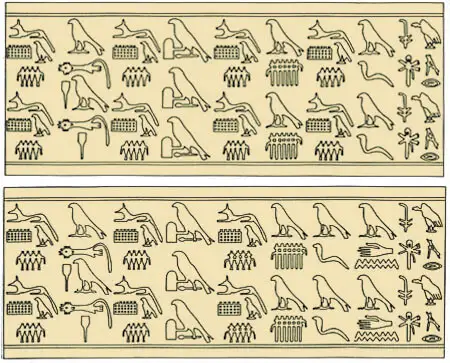
Bibliography
- Dreyer, G., 1986. Ein Siegel der frühzeitlichen Köningsnekropole van Abydos. MDAIK, 43: 33-43. Abb. 2-3. Taf. 4-5
- Kaiser W., 1986. Zum Siegel mit frühen Königsnamen von Umm el-Qaab. MDAIK, 43: 115-119; Abb. 1-2.
King list of Qa’a
8 pharaohs
Date: Reign of Qa’a (Dynasty I)
Provenance: Abydos tomb Q
Description: Seal impression containing a sequence of eight names: Narmer, Aha, Djer, Wadj, Den, Anedjib, Semerkhet, and Qaa. This seal confirms that Narmer was the first king of the dynasty, as on the Den seal (above.) Queen Merneith’s name is absent, which seems to further confirm that she acted as regent for a young Den.
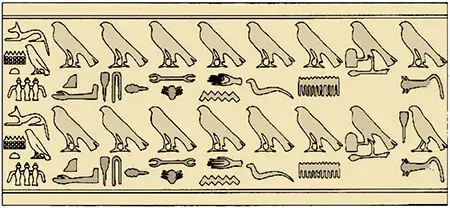
Bibliography
- Dreyer G. et. al., 1996. Umm el-Qaab. Nachuntersuchungen im frühzeitlichen Königsfriedhof. 7./8. Vorbericht. MDAIK, 52: Abb. 26. Taf. 14 b, c.
Wadi Hammamat king list
5 pharaohs
Date: Dynasty XII-XIII
Provenance: Wadi Hammamat rock inscription
Description: The rock inscription at Wadi el-Fawachir in Wadi Hamamat consists of with five royal names and a short honorary prayer. Based on paleography, it is generally thought that the list was not contemporary with the fourth dynasty, but rather created during the twelfth or thirteenth dynasties – some 600 years later. The five names are (rightto left): Khufu, Radjedef, Khafra, Hordjedefra, and Baufra.
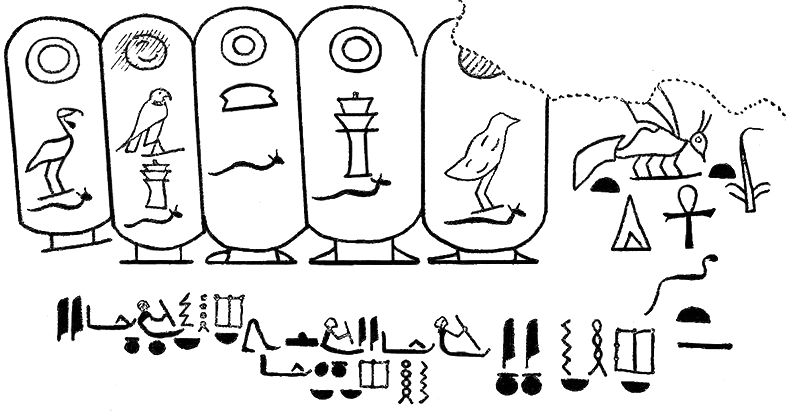
Bibliography
- Drioton, E., 1954. Une Liste des Rois de la IV Dynastie dans l’Ouadi Hammamat. BSFE, 16: 41-49.
- Janosi, P., 2005. Giza in der 4. Dynastie. Die Baugeschichte und Belegung einer Nekropole des Alten Reiches, Vol. 1: 64-65.
The Royal Annals
26 pharaohs
Date: Dynasty V
Provenance: unknown, maybe Memphis
Description: The seven surviving fragments of a stele known as the Royal Annals of the Old Kingdom of Ancient Egypt include the Palermo Stone and its associated fragments. The stele contained a list of the kings of Egypt from predynastic kings through to the early part of the Fifth Dynasty and noted significant events in each year of their reigns. Because most of the stele is missing, the names that could be found on it is lost, but can be inferred by counting their known or assumed length of reign. This is obviously not a guarantee that a certain name was actually found on here.
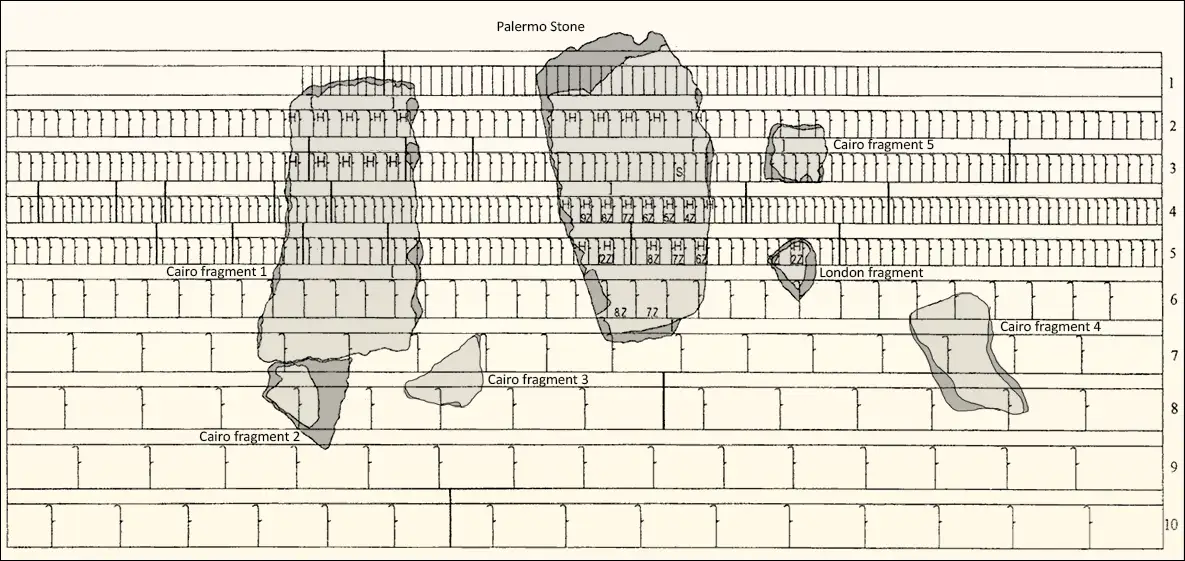
Names in the Annals
| Fragment | Names found | Implicit names |
|---|---|---|
| Palermo | Predynastic: Imikhet, Wenegbu, Niheb, Tiu, Itjiesh, Khaiu, and Seka Dynastic: Sneferu, Shepseskaf, | . |
| Cairo 1 | Djer, Sneferu, | Aha |
| Cairo 2 | Khufu, | ..... |
| Cairo 3 | Djedefra, | ..... |
| Cairo 4 | Sneferu, Khufu, | ..... |
| Cairo 5 | Den | Aha |
| London | ..... | ...... |
Bibliography
- Breasted, James H., 1906. Ancient Records of Egypt, Vol. 1. Chicago: §§ 76–167.
- Beckerath, J. von., 1997. Chronologie des Pharaonischen Ägypten. Mainz.
- Maspero, G., 1915. Le Musée égyptien: recueil de monuments et de notices sur les fouilles d’Egypte, Vol 3. Cairo: 29-53, plates XXIV-XXXI.
- Sethe, Kurt., 1933. Urkunden des alten Reiches, Vol. 1. Leipzig: 235-249.
- Wilkinson, T., 2000. Royals Annals of Ancient Egypt. London, New York.
South Saqqara Stone
4 pharaohs
Date: Dynasty VI
Provenance: Saqqara, storeroom south of the pyramid of Queen Iput II.
Description: The South Saqqara Stone is a large basalt stone that was originally inscribed on both sides with annual records of
several kings of the Old Kingdom. These annals include the Sixth Dynasty pharaohs Teti, Userkara, Pepi I, Merenra I, and Pepi II.
Unfortunately, the inscriptions were erased when the stone was reused as the sarcophagus lid for queen Ankhenespepi I during Pepi II’s
early years. Fortunately, the craftsman erasing the inscription did not do a particularly good job, as faint traces of the original still
remain.
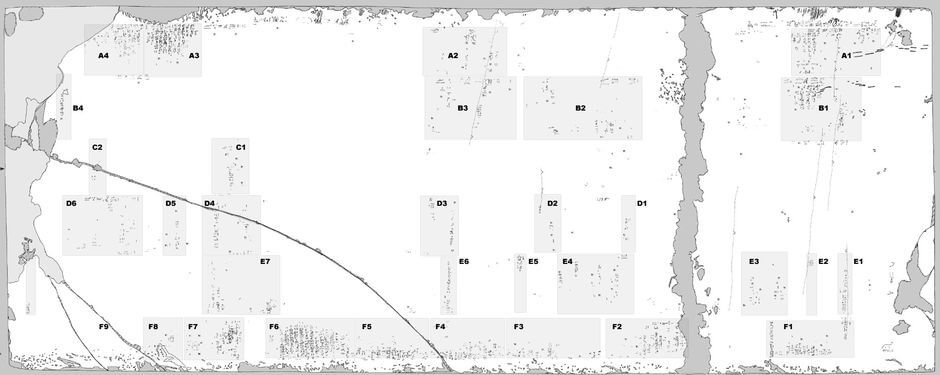
Bibliography
- Baud, M & Dobrev, V., 1995. De nouvelles annales de l’Ancien Empire égyptien. Une 'Pierre de Palerme' pour la VIe
dynastie.
BIFAO, 95: 23-63.
Tomb of Sekhemkara
5 pharaohs
Date: early Dynasty V
Provenance: Giza central field. Tomb 89 of Lepsius (G 8154).
Description: Five consecutive rulers are honoured in an inscription on a false door in his tomb, which is located southeast of the pyramid of his father Khafra. As the eldest son of the pharaoh, he was also Chief Justice and Vizier.
Names in the scene:
1. Khafra 2. Menkaura 3. Shepseskaf 4. Userkaf 5. Sahura
Bibliography
- Lepsius, Karl R., 1849. Denkmäler aus Ägypten, Vol. 2: pl. 41a.
- Sethe, Kurt., 1933. Urkunden des alten Reiches, Vol. 1: §15(106), 166.
- Porter and Moss. Topographical Bibliography, Vol. 32: 233-34.
Tomb of Netjerpunesut (Nesutpunuter?)
6 pharaohs
Date: early Dynasty V
Provenance: Giza, central field, small mastaba (G 8740).
Description: Entrance doorway lintel with the names of six kings.

Names in the scene:
1. Radjedef 2. Khafra 3. Menkaura 4. Shepseskaf 5. Userkaf 6. Sahura
Bibliography
- Sethe, Kurt., 1933. Urkunden des alten Reiches, I, §16(107), 166
- Porter and Moss. Topographical Bibliography, III2, 278
- Gauthier., 1925. ASAE, 25: 180.
- Reisner., 1942. A History of the Giza Necropolis, Vol. 1: 314 (a) Mastaba of Neter-puw-nesuwt.
- Junker., 1938. Giza III: 51 (no. 50)

